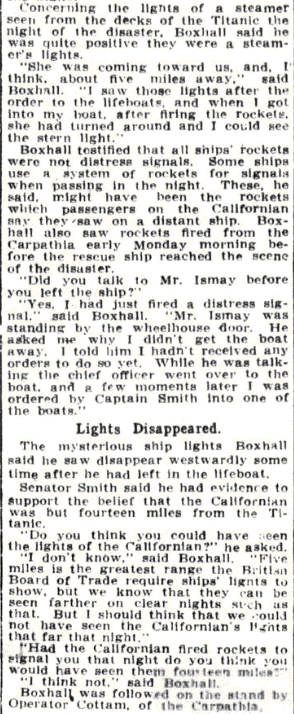The Californian Incident
"In 1912, as history recalls it, Captain Stanley Lord commander and the crew of the Californian stood idle by while the Titanic went down with more than 1500 men, women and children. Two commissions investi- gated the incident and both (The US and British Inquiries) ruled Lord was negligent".

At 12.45 am, it is said that passengers and officers on the Titanic observed a dim light coming from un unknown or mysterious ship in the distance. 4th Officer J.G.Boxhall began firing distress rockets to attract the attention of this mysterious ship. Instead of responding to the Titanic's distress rockets, the light went further away until it dissapeared and with it the Titanic's passengers last glimmer of hope.
Was the dim light in the distance coming from the Californian? Or was it the Samson, a Norwegian boat illegally hunting seals on the night of April 14? Or was it the SS Mount Temple, a Canadian cargo ship. Rumors that Mount Temple under Capt Moore ignored Titanics distress rockets, abounded at the time and persist to this day. And then there was a ship known as the Hellig Olav. The Olav docked at New York April 17 and is reported to have encountered an iceberg near where the Titanic sank. It has been suggested that the Olav may have been the ship whose lights 4th officer Boxhall saw which he ineffectually tried to signal with distress signals.
Official investigations into the Titanic disaster indicated that it was the Californian. The issue was not the Californian's exact position but whet- her she was close enough to see distress rockets fired from the Titanic and whether she might have been able to reach the sinking Titanic in time. The inquiries concluded that the ship was close enough.
"The Californian, controlled by the same concern as the Titanic, was nearer the Titanic than the nineteen miles reported by her captain, and her officers and crew (they) saw the distress signals of the Titanic and failed to respond in accordance with the dictates of humanity, international usage and the requirements of laws.
Had she done so she might have saved many if not all of the lives that were lost. There were no serious hindrances - the night was clear, the sea smooth and the ice was loose ice extending for a distance of not more than two or three miles in the direction of the Titanic.
That his ship Californian was the steamer reported to have passed within 5 miles of the sinking liner and to have disregarded signals for help, Capt. Lord denied positively. "I figure that we were from 17 to 19 miles distant from the Titanic that night."
He said. "About 10.30 o'clock that sunday night we steamed into an immense ice field and immediately our engines were shut down to wait for daylight. With the engines stopped the wireless was, of course, not working, so we heard nothing of the Titanic's plight until the next morning." Sometime after 5 o'clock, monday morning,the wireless operator caught a message from the Allen liner Virginian, stating that the Titanic had sunk. As soon as Captain Lord discovered that it was the Titanic which had sunk, the engines were started up. And despite the floe, started off at full speed for the spot where the great liner had sunk. Three hours later (8 o'clock) she arrived at the Titanic wreck scene.
Sir Rufus Isaacs, attorney general, indicated that there would be a material difference between the stories of the Captain and his officers in regard to the steamer seen from the deck of the Californian during the night of the catastrophy. Evans, wireless operator on the Californian told of having been awakened about 5 o'clock monday morning by the 4th officer, who said to Evans:"There's a ship been firing rockets in the night. Please see if there is anything the matter." Evans told of the gossip on the Californian regarding the rockets seen in the night and said the 4th officer told him he had used the Morse signals in an effort to get in communication with the ship.
It is said that the Californian failed to respond to the distress rockets and Morse signals and that Boxhall failed to receive any reply. Another report, however, says the Californian did reply to the rockets and signals. Stewards and Captain Smith all declared they saw them.

Until the day he died, in 1962, Lord insisted he was innocent of any wrongdoing. He said his ship was at least 30 miles away when the Titanic hit an iceberg and sank. And that he had been falsely accused of letting 1500 people die. Capt. Lord said that had he known of the Titanic's plight all the latter's passengers could have been saved.